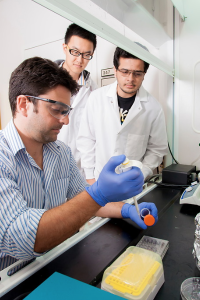Document Type
Article
Publication Title
Frontiers in Plant Science
Abstract
Chlamydomonas reinhardtii (Cr), a unicellular alga, is routinely utilized to study photosynthetic biochemistry, ciliary motility, and cellular reproduction. Its minimal culture requirements, unicellular morphology, and ease of transformation have made it a popular model system. Despite its relatively slow doubling time, compared with many bacteria, it is an ideal eukaryotic system for microplate-based studies utilizing either, or both, absorbance as well as fluorescence assays. Such microplate assays are powerful tools for researchers in the areas of toxicology, pharmacology, chemical genetics, biotechnology, and more. However, while microplate-based assays are valuable tools for screening biological systems, these methodologies can significantly alter the conditions in which the organisms are cultured and their subsequent physiology or morphology. Herein we describe a novel method for the microplate culture and in vivo phenotypic analysis of growth, viability, and photosynthetic pigments of C. reinhardtii. We evaluated the utility of our assay by screening silver nanoparticles for their effects on growth and viability. These methods are amenable to a wide assortment of studies and present a significant advancement in the methodologies available for research involving this model organism.
DOI
10.3389/fpls.2018.00235
Publication Date
3-22-2018
Recommended Citation
Haire, T. C., Bell, C., Cutshaw, K., Swiger, B., Winkelmann, K., & Palmer, A. G. (2018). Robust microplate-based methods for culturing and in vivo phenotypic screening of chlamydomonas reinhardtii. Frontiers in Plant Science, 9 doi:10.3389/fpls.2018.00235



